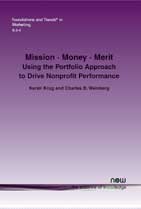Mission • Money • Merit: Using the Portfolio Approach to Drive Nonprofit Performance
By Kersti Krug, The University of British Columbia, Canada, kersti.krug@telus.net | Charles B. Weinberg, Sauder School of Business, The University of British Columbia, Canada, charles.weinberg@sauder.ubc.ca
Abstract
Nonprofit organizations are continually faced with the challenge of where to allocate their limited funds and other resources across the diverse range of programs that they offer. Rather than examining each program separately, nonprofits should view their activities as a portfolio of programs. Mission, Money, and Merit are the three critical axes for strategic management of a nonprofit's portfolio.
The M3 portfolio approach developed here visually presents the size (typically cost) of each program, as well as the relationships among the programs relative to the nonprofit's mission, resource-cost coverage, and performance quality. The portfolio model then measures the center of gravity for the nonprofit on each axis and the overall balance of the organization's activities. By presenting the complexity of any organization visually and colorfully, management can better see and judge what programs may need enhancing, changing, or eliminating.
But this is not all the model offers. Through its participatory approach of asking managers to independently rate each of the programs on the three axes, hidden assumptions are illuminated, differences are highlighted, agreements are shared, and learning takes place. The enhanced communication among managers that occurs as a result of this process contributes enormously and directly to the quality of strategic and tactical decision-making by the nonprofit toward greater productivity, effectiveness, sustainability, balance, and success.
Mission • Money • Merit
Mission • Money • Merit is intended to help not-for-profit management - including executives, board members, senior professionals, and administrators - to visualize and manage complexity in colorful, innovative, and winning ways. By adopting the approaches that are described here, nonprofits can enjoy these nine advantages: (1) easily visualize the programs in the organization's portfolio, (2) agree on how each program advances or detracts from mission, (3) understand what each program costs and brings in as revenue, (4) assess capabilities, outcomes, and performance for each program, (5) decide which programs should be grown, cut, and/or changed, (6) focus more efficiently and more courageously, but less riskily, on programs that need most attention, (7) allow each participant around the senior management table to safely discover what they and their colleagues know, what they don't know, and how to contribute more effectively to the collective enterprise, (8) participate actively in organizational learning, and (9) perhaps most importantly, bring a healthy and effective balance to the organization as a whole. The monograph describes in greater detail how nonprofits can use the three-dimensional M3 model to improve strategic decision-making by providing a framework to clarify and even simplify this challenging process; make the delivery of mission-driven services more sustainable and the organization healthier; help managers decide which services to enhance, which to maintain, and which to drop; improve communications within the organization; enhance the knowledge and performance of board members, executives, professionals, and administrators who contribute to or influence critical decisions; and achieve productive organization-wide balance. Mission • Money • Merit covers the context, value, and use of the M3 model for nonprofits, and includes a variety of experiences of organizations around the world which illustrate how different approaches to strategic decision-making can bring about great success or become timely warnings of impending failure.
